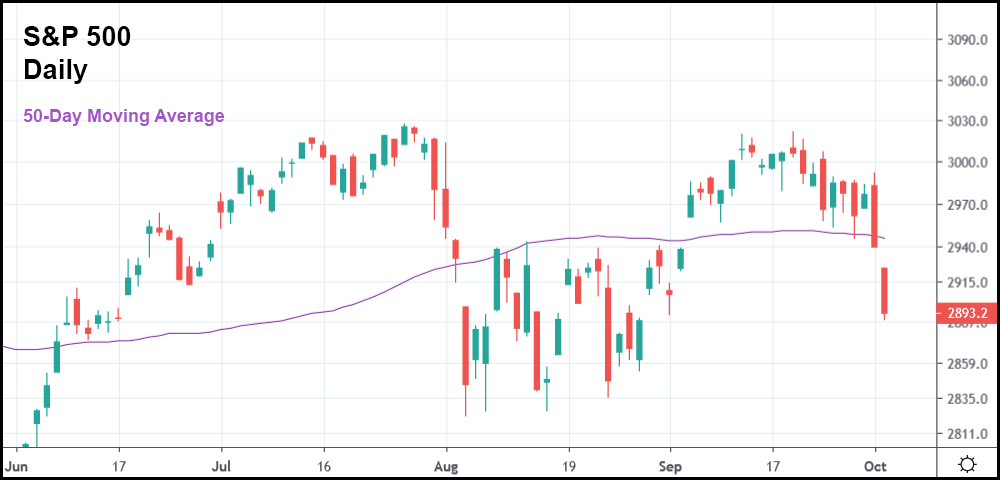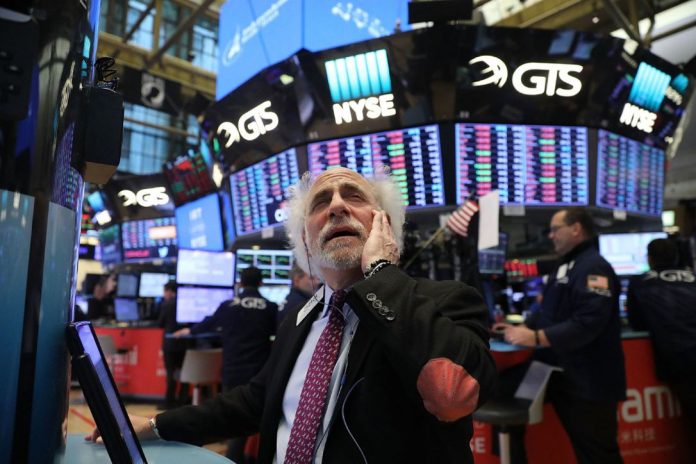Fundamental market analysts are feeling very confused these days. The major indexes, despite dropping significantly since mid-September, are still within striking distance of their all-time highs.
Manufacturing has shrunk to its lowest level in 10 years, but consumer confidence readings just beat expectations. And while it’s true that early corporate earnings have been somewhat of a mixed bag, they’re in no way indicative of a looming recession.
So, what’s going on? Is the market headed higher? Even Fed Chairman Jerome Powell said that the U.S. economy looks moderately strong when he announced the last rate cut.
Technical analysts, who focus almost entirely on the charts, have a different opinion. They’ve grown increasingly worried that a correction is almost here.
And looking at the recent price action, it’s hard to argue with that sentiment.

Stocks opened trading this morning at a moderate loss, before plunging even further into the red. As of midday, the S&P, Dow, and Nasdaq Composite are down roughly 1.50%. Yesterday, the indexes logged a loss of almost 1.2%.
And now, they’re all trading below the 50-day moving average – a key indicator for many technically-inclined analysts.
“If the outlook was turning bullish for equities, we would see the major benchmarks breaking to record highs with decisive and broad-based confirmation from breadth indicators. […] We would see yield curves steepening,” said Tim Hayes, chief global investment strategist at Ned Davis Research.
“[It’s] a reflection of waning confidence in the macro-environment globally.”
He continued, adding that this rally is quickly becoming “another round of failure.”
MKM Chief Market Technician JC O’Hara agrees with Hayes, noting that “the market is not in the best shape to make new highs from its current position” since “shorter-term technical indicators started to show some negative divergences.”
“We believe more time is needed to allow those indicators to fully reset, and thus are in a better position to make new highs,” he added.
Hayes is especially concerned about the “unbalanced” nature of the recent rally. U.S. indexes failed to regain July highs, and he believes it may have something to do with overachieving large-cap stocks – blue-chip companies that have masked the struggles of mid-level corporations.
“As the megacaps have been propping up the ACWI (All World Country Index ETF) and other cap-weighted indices, underlying deterioration has been reflected by the equal-weighted ACWI,” Hayes wrote in a note to clients. He sees it as a sign of “mounting economic pessimism.”
Moreover, Hayes pointed to the bond market as proof of how fragile the rally truly is. He says that if investors were optimistic, “we would see yield curves steepening again.”
And while Hayes may be correct that not everything’s shaking out quite the way it normally would, he’s also ignoring the fact that we’re in a highly irregular investing climate.
Over the last year, the central banks of the world raced to a zero-rate (or negative rate) environment like never before. Even the Federal Reserve is getting in on the madness, albeit not at quite the same pace.
Add an ongoing trade war into the mix, and you’ve got the makings of a very unique situation. Because of that, some of the traditional technical indicators aren’t making any sense. And when that happens, analysts like Hayes get worried.
Does that mean the rally is truly done for? Maybe, maybe not. We’ll find out throughout this upcoming earnings season. Because as usual, regardless of what else is going on, investors tend to reward companies that post impressive financials.
If that happens, I wouldn’t be surprised to see bulls finish out the year on a high note. If it doesn’t, then Hayes will have been right on the money with his analysis.
And investors will flee the market in droves.








